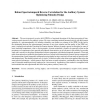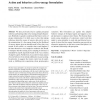824 search results - page 160 / 165 » The Structure Function and Distinguishable Models of Data |
BMCBI
2010
13 years 7 months ago
2010
Background: A growing demand for tools to assist the building and analysis of biological networks exists in systems biology. We argue that the use of a formal approach is relevant...
MOBICOM
2006
ACM
14 years 1 months ago
2006
ACM
Wireless sensor networks are tightly associated with the underlying environment in which the sensors are deployed. The global topology of the network is of great importance to bot...
CIVR
2008
Springer
13 years 9 months ago
2008
Springer
Since the emergence of extensive multimedia data, feature fusion has been more and more important for image and video retrieval, indexing and annotation. Existing feature fusion t...
JCNS
2000
13 years 7 months ago
2000
Abstract. The spectrotemporal receptive field (STRF) is a functional descriptor of the linear processing of timevarying acoustic spectra by the auditory system. By cross-correlatin...
BC
2010
13 years 4 months ago
2010
We have previously tried to explain perceptual inference and learning under a free-energy principle that pursues Helmholtz's agenda to understand the brain in terms of energy ...


